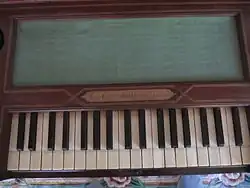 1786 Glasschord from the Hans Adler Collection | |
| Other names | Glasscord, Glassichord, Glace-chord |
|---|---|
| Classification | Idiophone |
| Inventor(s) | M. Beyer |
| Developed | 1785 |
| Related instruments | |
| Glass harmonica | |
| Builders | |
| Chappell & Co. | |
The glasschord (French: fortepiano à cordes de verre) is a struck crystallophone resembling the celesta, invented circa 1785[1] by physicist[2] M. Beyer of Paris.[3][4] It creates sound by using cloth covered wooden hammers to strike glass tubes laid on a cloth strip, with no dampeners. The instrument has a range of three octaves, in various models from c' to c'', f' to f'', and g' to g''.[5] The instrument was largely inspired by the glass harmonica created by Benjamin Franklin,[6] and was given the name glasschord by him.[7] On 6 July 1785, Thomas Jefferson that Franklin carried a version of the instrument with him, describing it as a sticcado.[8]
Beyer originally presented the instrument on 19 January 1785, in a presentation at the French Academy of Sciences, while the instrument still was nameless,[9] with the instrument being publicised in the Journal de Paris multiple times through the same year.[10]
Many glasschords were built by Chappell & Co., until around 1815.[11][12]
The instrument was used in some scores, most notable by Hector Berlioz, who wrote the first version of La Tempête, and Camille Saint-Saëns who used the instrument in L'aquarium.[13]
References
- ↑ Gétreau, Florence (1996). Aux origines du musée de la musique : les collections instrumentales du Conservatoire de Paris : 1793-1993. [Paris]: Editions Klincksiek. ISBN 2-252-03086-0. OCLC 36541348.
- ↑ Pernot, Laurent (1985). "Repas électriques". Bulletin d'histoire de l'électricité. 6 (1): 177–188. doi:10.3406/helec.1985.955.
- ↑ Traversier, Mélanie (2021). L'harmonica de verre et miss Davies : essai sur la mécanique du succès au siècle des lumières. Paris XIXe. ISBN 978-2-02-145146-7. OCLC 1333537233.
{{cite book}}: CS1 maint: location missing publisher (link) - ↑ Beyer, M. (1806). Notice sur le glace-chord de mon invention, et sur quelques autre instruments en verre, ainsi que sur divers objets de mécanique, que j'ai imaginé ou perfectionnés (in French). Paris. pp. 1–12.
- ↑ Schott, Howard (2001). "Glasschord". Grove Music Online. doi:10.1093/gmo/9781561592630.article.51553. ISBN 978-1-56159-263-0. Retrieved 2022-11-10.
- ↑ "Heart Blood of the World: The Hydrocrystalophone | Pennsylvania Center for the Book". pabook.libraries.psu.edu. Retrieved 2022-11-10.
- ↑ "2016 Florida International Toy Piano Festival Booklet" (PDF). The New Music Conflagration. Retrieved 10 November 2022.
- ↑ "Glasschord". music.yale.edu. Retrieved 2022-11-10.
- ↑ Cohen, Albert (2014-07-14). Music in the French Royal Academy of Sciences: A Study in the Evolution of Musical Thought. Princeton University Press. ISBN 978-1-4008-5354-0.
- ↑ "Glacechord". collectionsdumusee.philharmoniedeparis.fr (in French). Retrieved 2022-11-10.
- ↑ "Chapell & Co. | Glassichord | British | The Metropolitan Museum of Art". www.metmuseum.org. Retrieved 2022-11-02.
- ↑ "Edinburgh collection checklist". www.bate.ox.ac.uk. Retrieved 2022-11-10.
- ↑ Chapuis, Jean-Claude. "Ces si délicats instruments de verre". Pourlascience.fr (in French). Retrieved 2022-11-10.